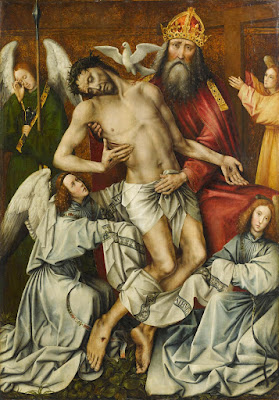 |
| Colijn de Coter Christ the Mediator with Philip the Fair ca. 1500 oil on panel (diptych) Musée du Louvre |
 |
| Colijn de Coter Virgin Mediator with Jeanne La Folle ca. 1500 oil on panel (diptych) Musée du Louvre |
 |
| Colijn de Coter Last Judgment Archangel Michael weighing Souls ca. 1495-1505 oil on panel (altarpiece fragment) Musées Royaux des Beaux-Arts, Brussels |
 |
| Colijn de Coter Last Judgment St Peter welcoming the Blessed ca. 1495-1505 oil on panel (altarpiece fragment) Alte Pinakothek, Munich |
 |
| Colijn de Coter The Damned ca. 1505 oil on panel (altarpiece fragment) Wallraf-Richartz Museum, Cologne |
 |
| Colijn de Coter Pruszcz Polyptych The Last Supper ca. 1500 oil on panel National Museum, Warsaw |
 |
| Colijn de Coter Pruszcz Polyptych Taking of Christ ca. 1500 oil on panel National Museum, Warsaw |
 |
| Colijn de Coter Pruszcz Polyptych Ascension of Christ ca. 1500 oil on panel National Museum, Warsaw |
 |
| Colijn de Coter Pruszcz Polyptych Descent of the Holy Spirit ca. 1500 oil on panel National Museum, Warsaw |
 |
| Colijn de Coter Descent from the Cross ca. 1495-1505 oil on panel (altarpiece fragment) Museo de Bellas Artes de Bilbao |
 |
| workshop of Colijn de Coter The Entombment ca. 1510 oil on panel Bonnefantenmuseum, Maastricht |
 |
| workshop of Colijn de Coter The Entombment (detail) ca. 1510 oil on panel Bonnefantenmuseum, Maastricht |
 |
| Colijn de Coter The Lamentation ca. 1510-15 oil on panel (altarpiece fragment) Rijksmuseum, Amsterdam |
 |
| Colijn de Coter The Holy Trinity ca. 1510-15 oil on panel Musée du Louvre |
 |
| Colijn de Coter Adoration of the Magi ca. 1500-1505 oil on panel Museum of Fine Arts, Ghent |
 |
| Colijn de Coter Virgin and Child crowned by Angels ca. 1490-95 oil on panel Art Institute of Chicago |
"Colijn de Coter directed a workshop in Brussels well into the 16th century, but his style and subjects reflect the traditions of the great 15th-century Netherlandish painters Robert Campin, Jan van Eyck, and Rogier van der Weyden. [In The Virgin and Child Crowned by Angels, directly above] the well-appointed, bourgeois interior underscores Christ's humanity, even as angels crown the Virgin as the Queen of Heaven. Like his predecessors, de Coter used details of the setting to emphasize both the human and divine aspects of Christ's nature. Thus, the lion carved on the arm of Mary's chair alludes to the biblical throne of Solomon, and the prayer inscribed on the hem of her cloak hails her as "mother of the king of angels." The somewhat claustrophobic treatment of space reflects de Coter's own style."
– curator's notes from the Art Institute of Chicago